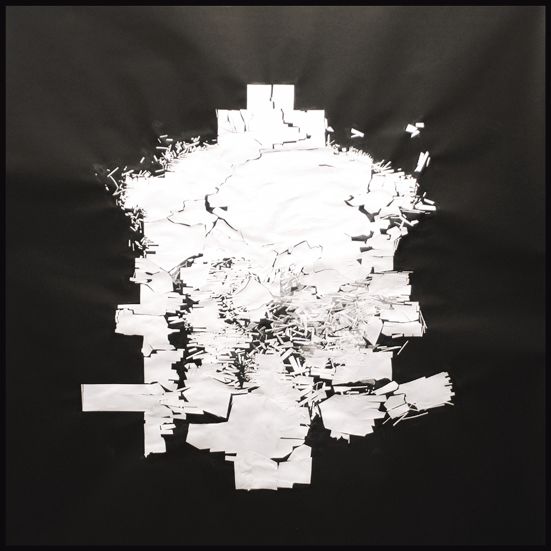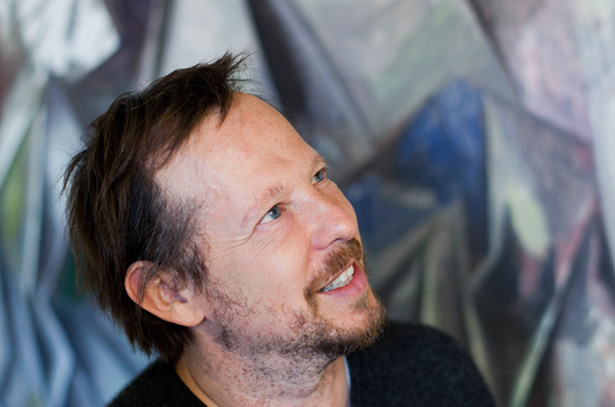
Guillermo Kuitca
23 March - 14 May 2005
London
Born 1961, Guillermo Kuitca is a key figure in the history of Latin American art whose work finds inspiration in the realms of architecture, dance, film and cartography. Hauser & Wirth London are delighted to present this prolific Argentine artist - who commands a strong international following - to a new audience in the UK. A limited edition catalogue accompanies the exhibition with texts by conductor Stephen Barlow and editor of ‘Modern Painters’ Karen Wright. Since the 1980s, Kuitca’s iconographic vocabulary has created numerous powerful and distinct bodies of work. His striking diversity of touch and potent reinventions on a panoply of motifs, such as apartment plans, maps, conveyor belts, crown of thorns, beds and institutional architecture ranging from stadiums to cemeteries, have introduced unexpected variations on these themes. Kuitca’s utilitarian imagery can be read as ‘locale’ in its most diagrammatic sense, but it is the artist’s curious conveyance of movement in all forms, in the home, through cities and in dreams that attempts to map physical and mental coordinates of a lifetime. The absence of the human figure in Kuitca’s repetoire evokes their presence by acknowledging the confining complexities of a modern society; reflecting on our place in a scene and on the world’s stage. The main gallery space features Everything, 2004, an impressive four-panel painting which interpolates fragments of American road maps. The enigmatic veined surface invites the viewer for closer inspection where one can identify the names of locations; painstakingly woven in parts. Devoid of any beginning, end, or coordinates, places dissolve within some larger unknown entity of no geographical order. Maps are one of Kuitca’s leitmotifs and have played an extensive role in his work. The graphic configurations function as his reading of tensions between one’s assignment of place and belonging, of home, but on the idea of the ‘place’ being Universal. Here, the viewer traces an imaginary journey, which goes, and returns, to nowhere. A sense of search and self-scrutiny on the weathered surface suggests loss and dislocation. A selection of Kuitca’s Theatre Collages (2003-2004), also exhibited in the main gallery, are based on seating charts of famous opera houses and theatres. Kuitca’s seating plans are magically transformed into hovering abstracts that allude to audiences. Incised with architectural precision, each work retains the view from the stage, looking out to the void of an auditorium. The treatments are different as he draws attention to the relationship between stage and audience. Various rich hues in Kuitca’s use of colour are seen interlapping and seeping into each other, almost reflecting the turbulent emotions of an audience in the grips of a performance. The results proffer a suspended state; a captured moment. Kuitca’s juxtaposition of private and public space is subtler in these works as the viewer’s eye is drawn to seats that would otherwise be occupied: individual, yet impersonal. The Ring (2003-2004), shown in the Vault Room, is a series based on Richard Wagner’s operatic Ring Cycle. Individually titled Das Rheingold, Die Walküre, Siegfreid and Gotterdammerung, Kuitca has referenced album covers of historic recordings of these operas. Formed with shredded paper, the collages create quivers and trembles that evoke a performance stirring within. There is here, a linking factor to Kuitca’s theatre collage Bayreuther Festspielhaus, 2004, of the opera house custom-built by Wagner and site of The Ring’s epic premiere in 1876. Guillermo Kuitca is one of Argentina’s most renowned artists. Travelling to Europe in the 1980s, he was inspired by a meeting with choreographer Pina Bausch and returned to Buenos Aires to direct and design several experimental theatre productions. In that period, the emergence of themes and imagery seen in his work to date, began to take form in his painting. The elemental structure of the bed, for one, a principle site of sleep and dreams, birth and death, was used to help create a feeling of individual isolation. He began a series on maps and apartment plans, sometimes tinged with religious motifs that still pervade his work in some form today. Kuitca’s reiteration of composite layouts have continued to emerge in his work as points of reference, often bringing us from interiors to exteriors and creates perspective spaces counteracted by his chosen medium. An interest in oppositions is best seen in his bed installation Untitled, 1992, shown at Documenta IX, where Kuitca painted maps directly onto the bed mattresses combining themes of sickness and death, with that of movement and life. Kuitca’s unique work continues to marry documentary fact with an almost surreal fantasy and reminds us, with symbols, of our interchangeable urban anonymity. Guillermo Kuitca has exhibited worldwide and his work is held in major collections, including MALBA, Buenos Aires, The Metropolitan Museum of Art and The Museum of Modern Art, New York, The Tate Gallery, London, Stedlijk Museum, Amsterdam and Hirshhorn Museum and Sculpture Garden, Washington DC. Major solo exhibitions include Museo National Centro de Arte Reina Sofia, Madrid (2003), Sperone Westwater, New York (2002, 1999) LA Louver Gallery, Venice (2002), Galerie Hauser & Wirth Zurich (2001), Foundation Cartier pour l’art contemporain, Paris (2000), Whitechapel Art Gallery, London (1995), MOMA, New York (1991) and Kunsthalle Basel, Basel (1990). Group shows include El Museo del Barrio, New York (2004), Moderna Museet, Stockholm (1998), The Carnegie Museum of Art, Pittsburgh (1995), National Gallery of Canada, Ottowa (1994), Documenta IX, Kassel (1992), Stedelijk Museum, Amsterdam (1989) and XVIII Bienal, São Paolo (1985). An upcoming USA retrospective is due in 2007, starting at the Hirshhorn Museum and Sculpture Park, Washington DC, details are still to be confirmed. The artist lives and works in Buenos Aires. Catalogue: GUILLERMO KUITCA – Theatre Collages, with texts by conductor Stephen Barlow and editor of Modern Painters Karen Wright.
Selected images

Covent Garden II
2004

The Old Vic
2004

Teatro Rojo
2004

Covent Garden IV
2004

Everything
2004

The Ring
2003
About the Artist

Guillermo Kuitca
Born in 1961 in Buenos Aires, where he continues to live and work, Argentine artist Guillermo Kuitca draws on a range of iconography, including architectural plans, maps, theaters, musical scores and domestic spaces to produce an oeuvre that explores themes of history, memory, structured absence, sound and silence and the tension between the empirical and abstract. Shifting from gestural mark-making to linear precision, Kuitca’s work mines varied aesthetic styles and histories, and in the latter half of his career, he has achieved significant acclaim for his deployment of a unique cubistoid style that masterfully reconciles abstraction with an illusionist form of figuration.
Exhibiting his first paintings at the age of thirteen at Lirolay Gallery in Buenos Aires, Kuitca quickly expanded his artistic practice by also studying drawing and theater direction. Early paintings from the 1980s incorporated theater imagery, informed by his experience in theater production and often explored themes of history, memory, migration, and domestic and communal spaces, before Kuitca later began to integrate architectural and cartographic subjects into his oeuvre. Having established himself as a leading figure in Buenos Aires’s art scene, in 1991—the same year that he founded his studio program in the city for residencies and young artists called Beca Kuitca—he staged his first solo museum exhibition in the United States, at the Museum of Modern Art in New York. A year later, he achieved further renown with his participation in documenta IX in Kassel, Germany—the first Argentine artist invited to documenta—where he displayed an installation of twenty mattresses.
The cubistoid style that Kuitca developed and that would emerge as the artist’s distinct visual language first appeared in his ‘Desenlace’ series, which he presented at the Argentine Pavilion at the 2007 Venice Biennale. Recalling a cubist aesthetic and eschewing figurative references, these segmented forms and angular patterns acted as the organizing principle of his compositions in this series and have recurred throughout his oeuvre ever since.
Recent, major solo exhibitions of Kuitca’s work include the Museo de Arte Contemporáneo Atchugarry, Uruguay (2023); Kunsthaus Pasquart, Biel, Switzerland (2017); Pinacoteca do Estado de São Paulo, Brazil (2014); The Drawing Center NY (2012); Hirshhorn Museum and Sculpture Garden, Washington D.C. (2010); and Walker Art Center, Minneapolis MN (2010).
Kuitca’s work is represented in distinguished museums and collections worldwide, including the Art Gallery of Ontario, Toronto; Art Institute of Chicago IL; Buffalo AKG Art Museum NY; Centre Pompidou, Paris; Dallas Museum of Art TX; Fondation Cartier pour l’art contemporain, Paris; Hirshhorn Museum and Sculpture Garden, Washington D.C; Kunsthaus Pasquart, Biel, Switzerland; Lille Métropole Musée d’art moderne, d’art contemporain et d’art brut; Los Angeles County Museum of Art CA; The Metropolitan Museum of Art NY; The Morgan Library & Museum NY; Musée d’Art Moderne Grand-Duc Jean, Luxembourg; Museo de Arte Moderno de Buenos Aires; Museo Jumex, Mexico City; Museo Nacional Centro de Arte Reina Sofía, Madrid; Museum of Fine Arts, Boston MA; Museum of Fine Arts, Houston TX; Museum of Modern Art NY; National Gallery of Victoria, Melbourne; Pérez Art Museum Miami, FL; Smithsonian Institution, Washington, D.C; Solomon R. Guggenheim Museum NY; Stedelijk Museum, Amsterdam; and Tate, London.
Current Exhibitions
1 / 12













